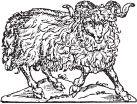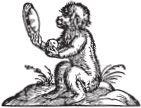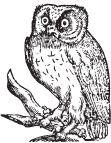Read Witchcraft Medicine: Healing Arts, Shamanic Practices, and Forbidden Plants Online
Authors: Claudia Müller-Ebeling,Christian Rätsch,Ph.D. Wolf-Dieter Storl
Witchcraft Medicine: Healing Arts, Shamanic Practices, and Forbidden Plants (49 page)

Sinister Companions of the Witch
Identifiable plants that are associated with witches are seldom found in portrayals of witches. Ultimately this comes as no surprise—after all, one is not horrified by a plant like henbane, with its pretty blossoms. Despite all interpretive efforts this poisonous plant radiates nothing that could be construed as negative. But when it comes to the prickly thistle, thornbush, or nettle it’s a different story. When we see these plants we are all too quickly reminded of direct painful encounters. Thistles, thornbush, and nettles are occasionally found in pictures of witches, such as the one by Hans Weiditz.

The salamander, symbol of alchemy, is one of the typical ingredients of the magic potions brewing in the witches’ cauldron. The poison in the salamander’s skin contains psychoactive compounds. In Slovenia a psychedelic schnapps is still distilled from live salamanders. (Woodcut, 16th century.)
The frightening elements of the plant world are better expressed in written form. In the end, the illustrative scenes of witches were meant to convince the observer of the evil endeavors of these notorious women. Thus, certain animals are customarily represented; due to their appearance or habits, the animals that are depicted have a sinister aura and can elicit revulsion and fear. Examples from the “revolting menagerie” include spiders, toads, owls, and snakes.
23
The witch craze itself contributed to the fear-inducing image that was attached to the animals: For example, their black color had disastrous effects on the cultural fate of ravens, cats, bats, rats, and various insects, which over time were turned into diabolic animals and disease demons.
24
Because of this tradition of demonization, most of these animals must seriously fight for their survival, because humans barely grant them the right to exist.
Over the course of Western history humans have increasingly claimed the living space of the wild animals for settlements, farmland, and pastureland for their domesticated “working” animals. Humans thus wound up in conflicts with animals such as the bear and the wolf, which were demonized as beasts. This mind-set has prepared the soil for the animals’ extinction. A call for the elimination of “pests” has been systematically fed in pictures and words, and the resulting notions can still be observed today. For example, in
Brehms Tierleben
[Brehm’s Life of Animals] from 1878 the wolf is called “a destructive predator.” The 1895 edition, published by Brockhaus, reported that the wolf was known for its blood lust and cowardice, and that the “best way to exterminate it is by clearing the forests and shooting it.” This goal has been fulfilled, and the announcement of the wolf’s extinction was recorded in the 1974 edition of the book.
25
Back to the time of the witch trials. As humans congregated into settlements, they set themselves up behind high city walls and forts and in protected rooms. The more they moved out of the country and into the city, the more they distanced themselves from nature, alienating themselves from nature’s way of being and appearances. The local deities and nature spirits—the nymphs of the springs, the sylphs, and the fairies of the air—became alien. And beings that become alien because their way of life is no longer known mutate into frightening ghosts. In the imagination of the city dwellers, behind the gates of their growing settlements monsters lurked in the woods, the swamps, and the mountains, where they laid in wait for their victims.

Inside settlements, on the other hand, the forces of nature lose their immediate threat. For this reason humans have become increasingly fearful of the images of their own spiritual life, of the inner life of the human. People fear their own personal thoughts and desires, suffering increasingly from centuries of rhetorical bombardment by clergy promulgating dramatic images of teeth-bearing and clawing demons of desire.

According to heathen ideas, the presence of the gods is revealed in nature. Subsequently, animals stand close to the Divine; animal-human hybrids represent the numinous. But in Christian thought animals do not have souls, which is why the incarnation of the devil must be tamed by the culture of humans. Beloved depiction of such taming is embodied in the archangel Michael or in Saint George fighting the dragon.

Saint Augustus taught that
aves sunt daemones
(“birds are demons”). Birds are no longer symbols of the soul, as they were in ancient tradition; these animals threaten humanity’s peaceful soul. Hence predators such as the owl and raven, who are traditional companions of the witches, are frequently portrayed as threatening.

The owl
.
The owl is sinister. Its flight is silent and its feather dress allows it to blend in with the forest, where it often sits perfectly still on a trunk and observes the area with its phosphorescent eyes and its head, which can turn almost 180 degrees.
In antiquity the owl was a symbolic bird of Minerva, the goddess of knowledge and wisdom. The Romans, who worshipped her as the patroness of the arts and crafts, identified her with the Greek goddess Athena, whose “headquarters” were in Athens. But the owl’s story was different during Christian times. According to old sources and pictures from the Netherlands, including those of Bosch, the owl is a diabolical animal that embodies lies, blindness, ignorance, insanity, and drunkenness. The owl appears in many depictions of the temptation of Saint Anthony in conjunction with sexual seduction and as a symbol of heresy.
26

The raven
.
People who live in connection with nature, such as Native Americans on the West Coast of North America, honor the raven as a totem animal—a sacred messenger between the shamans and the gods. Among the Greeks the raven was the bird of Apollo. In Germanic mythology ravens, called
Hugn
and
Munin
(thought and memory), were companions of Odin/Wotan. To all northern peoples the raven was a transmitter of culture, and some even believed that a raven made the human race.

In the Christian context the raven was denigrated as the embodiment of the devil because of its black color. Its screeching, which rings through the fog on cold autumn days, has a haunting effect. These shrieking birds feed on carrion. When the gallows were still part of daily existence, people encountered ravens there and at cemeteries; for this reason they were feared as unclean birds of bad luck. The raven, like most animals that surround the witches, are under the rule of the planet Saturn, and became the traditional companions of the witch. This idea influenced the collective consciousness so much that ravens stereotypically sit on the shoulders of witches. In a variety of cultures fly agaric, the psychoactive
Amanita muscaria
mushroom, is called raven’s bread.

Blood and all other forms of animal excretions have always been associated with the underworld, the chthonic energies, and the witches’ brews, and have been included in medicine chests known as “filth-pharmacy” since ancient Egyptian times. (Woodcuts from Lonicerus,
Kreüterbuch
, 1679.)
